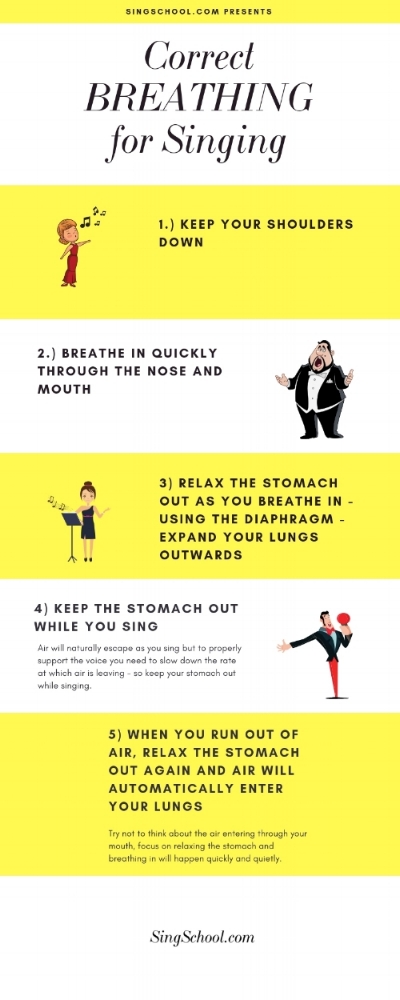The Right Breathing for Singing
So here’s the low down when it comes to the right breathing for singing.
It’s NOT intuitive.
That’s right. It’s not something people tend to do naturally - you really have to learn how to do it because the way you breathe for singing is the opposite to how you naturally breathe. Normal breathing is automatic and involuntary, it’s shallow and happening all the time. But breathing for singing is conscious, and in the process you have to fight the body’s natural urge to exhale.
That’s what we call “breath support” or “support from the diaphragm.”
Now the diaphragm is the muscle that controls the movement of air in your lungs. Here’s the thing though… you can’t see or touch your diaphragm. So in order to control it we have to control the muscle connected to it - the abdominal wall.
Breath support is the basis.
Breath support is the basis for everything in singing. If you do it properly you should have zero tension in your throat. It’s also the reason you can make a sound in the first place because without moving air, there’s nothing to vibrate the vocal cords.
Proper Breathing for singing
So let me explain the right breathing for singing.
THE INHALE
Breathe in and RELAX your stomach. That means the stomach should move outwards when you breathe in. You may have to really work on this because we often hold our stomach’s tight all day long. But the wall of the abdomen is the only way we can control the diaphragm, so as we breathe in we’re setting up the process where we will control the air later on. To do that - your stomach has to move outwards! Because then - the diaphragm moves down, and in doing so - like a vacuum - air gets sucked into your lungs, and the diaphragm switches ON.
As you breathe in make sure your shoulders stay down - your shoulders shouldn’t move when you breathe, that is called “shallow breathing” which gives us zero control later on. You know those people that literally get taller when they breathe? - don’t do that. Remember: we need our stomach to move out when we breathe, otherwise we won’t be able to slow down the rate that air rushes OUT of our lungs. Why? because we need the diaphragm to do that. (and if your stomach doesn’t move = no diaphragm!)
Also - as you breathe in - let your rib cage expand outwards at the back - left and right. So if someone stood behind you with their hands on your floating ribs (they are the ribs lower down at the bottom of the rib cage, they’re actually more movable) their hands would feel the expansion. You can also do this yourself. So what you want is expansion forwards in your stomach - and left and right at the back.
Keep in mind when you first do this, you might feel like you have no support at all. A lot of people are used to the feeling of tightness in their chest when they’re full of air but that is “shallow” breathing. Once you start breathing “low” - as opposed to high - (low being when you include the diaphragm) - it’s a much more relaxed feeling. But feeling that tension as your ribs expand at the back can help that feeling of fear and discomfort. However - to breathe correctly you really need to start to trust that your diaphragm is doing the work for you.
Download your free ebook download on The Right Breathing for Singing here:
THE EXHALE
OK, so that was the inhale! Now comes the real work.
5. As you start to sing, (with your stomach out and ribs expanded) - engage your abdominal wall, just a tiny bit, contract those muscles in your stomach. By that I mean, you should have a bit of the feeling you get when you do a sit-up or flex your abs. You don’t need to squeeze really hard, just a little bit as you start to sing. That control of your stomach muscle starts to control the diaphragm. And the secret to it all - don’t let your stomach collapse. Keep that tension in your stomach and that will keep the diaphragm in a position that keeps the air in your lungs for as long as possible!! Amazing right?
6. Obviously, as you sing through your phrase you will naturally start to run out of air. And as you feel that happening - you engage more and more your abdominal wall, and fight the urge for it to collapse. By the end of your phrase your stomach muscle might actually start to feel like you’ve done ten sit ups. But that is GREAT. That means you’re maximizing the resistance to the air leaving your lungs.
And that, my friend, is how we don’t run out of air so easily in singing, AND how we protect our voices from straining.
So that’s a basic run down of the right breathing for singing. If you have any questions or thoughts I’d love to hear from you in the comments.
Here’s to doing what we love x
Fiora

